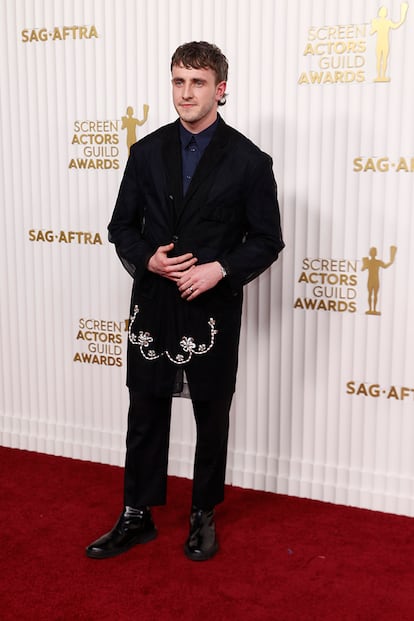Latest news on the mullet, the 1970s hairstyle that won’t give up
The origin of this iconic hairstyle is attributed to the nomadic horsemen of the Eurasian steppe

The mullet is the indestructible Terminator of hairstyles. We are talking about a haircut that reached the zenith of its popularity in the period of atrocious aesthetic regression that is remembered as the 1970s. It has since been viciously reviled and left for dead by the arbiters of good taste. But despite what would appear to be only 50 or so years of history, the eccentric haircut’s origin is attributed to the nomadic horsemen of the Eurasian steppe. And in Spanish-speaking countries it has received such picturesque names as choco, corte playero, tracas, greñas or cubana. The style has battled both time and tide, to remain some people’s choice of coiffure in almost all four corners of the planet.
On December 3, the latest Mulletfest, or the (unofficial) World Mullet Championship, was held in the only Irish pub in Kurri Kurri, a few miles from Sydney, in the Australian state of New South Wales. A certain Alastair Bush, a doctor residing in Dorset (United Kingdom) won the competition. His is an orthodox mullet, with sparse bangs, closely cropped sides and a wild exuberance around the nape of the neck — as the rules dictate. Bush, who had traveled over 6,200 miles to participate in the contest, posed with his trophy and declared he was “very proud” of his feat. But he wanted to make it clear that the mullet he is wearing is not a posthumous tribute to David Bowie, but rather the result of a “philanthropic project” as part of a campaign to raise funds against testicular cancer.
So far, there is nothing out of the ordinary. On a planet populated by more than 7 billion humans, it is not so strange that a hairstyle from another era, no matter how controversial it may be, is still around. The truly curious thing about the matter is that, at least in the opinion of trend experts such as The Guardian editor Chloe MacDonnell, the mullet has made a vigorous resurgence in recent months and has even reappeared on the red carpets with free agents as determined as the Irish actor Paul Mescal.

MacDonnell has spotted such eloquent symptoms of the mullet’s re-emergence as the pace at which The Mullet Society Instagram account is growing, the several million views that the mullet hashtag accumulates on Instagram, and the growing list of celebrities who are turning to the dark side, from Miley Cyrus to Emma D’Arcy, including Lil Nas X, Amber Valletta, Emma Corbin, and Timothée Chalamet. The Guardian, the new official bulletin of the resurrection of the mullet, also informed us not so long ago of the existence of Tami Manis. The Tennessee woman holds the record for the longest mullet on the planet, with a lustrous mane measuring 5 feet 8 inches that she began to grow 33 years ago and has continued to nurture like a prize palomino.
By her own admission, Manis belongs to the tribe of nostalgic Michael Bolton and Andre Agassi fans. They are still the majority in mullet territory, but no longer the only ones. Megan Bradley, from The New York Times, explained a few months ago that the style is being embraced by an increasingly large group of free-spirited Generation Zs who are prone to aesthetic subversion. Bradley welcomes them to a rich tradition that, as she has researched, runs from ancient Assyria to Rihanna, passing through the Greece of Homer’s epic poems, the Blackfeet people of the State of Montana, or the First Nation peoples of the Canadian Pacific. As I said, the mullet comes from a long time ago, and like Skynet’s T-1000, it doesn’t give up.
Sign up for our weekly newsletter to get more English-language news coverage from EL PAÍS USA Edition
Tu suscripción se está usando en otro dispositivo
¿Quieres añadir otro usuario a tu suscripción?
Si continúas leyendo en este dispositivo, no se podrá leer en el otro.
FlechaTu suscripción se está usando en otro dispositivo y solo puedes acceder a EL PAÍS desde un dispositivo a la vez.
Si quieres compartir tu cuenta, cambia tu suscripción a la modalidad Premium, así podrás añadir otro usuario. Cada uno accederá con su propia cuenta de email, lo que os permitirá personalizar vuestra experiencia en EL PAÍS.
¿Tienes una suscripción de empresa? Accede aquí para contratar más cuentas.
En el caso de no saber quién está usando tu cuenta, te recomendamos cambiar tu contraseña aquí.
Si decides continuar compartiendo tu cuenta, este mensaje se mostrará en tu dispositivo y en el de la otra persona que está usando tu cuenta de forma indefinida, afectando a tu experiencia de lectura. Puedes consultar aquí los términos y condiciones de la suscripción digital.
More information

Mullet revival? The 1980s haircut that is sweeping TikTok

Everything you need to know about butterfly bangs
Últimas noticias
Most viewed
- Sinaloa Cartel war is taking its toll on Los Chapitos
- Oona Chaplin: ‘I told James Cameron that I was living in a treehouse and starting a permaculture project with a friend’
- Reinhard Genzel, Nobel laureate in physics: ‘One-minute videos will never give you the truth’
- Why the price of coffee has skyrocketed: from Brazilian plantations to specialty coffee houses
- Silver prices are going crazy: This is what’s fueling the rally









































